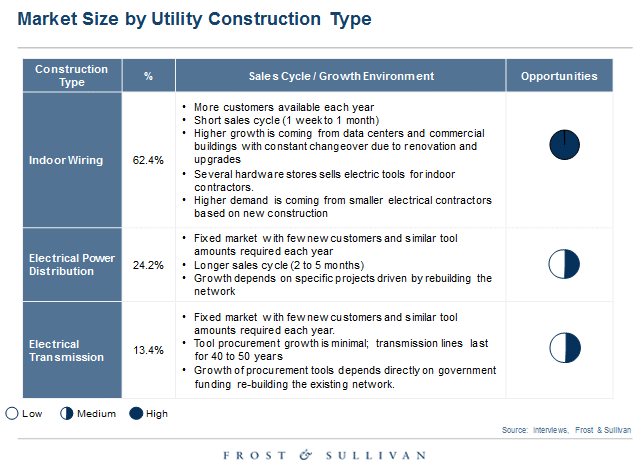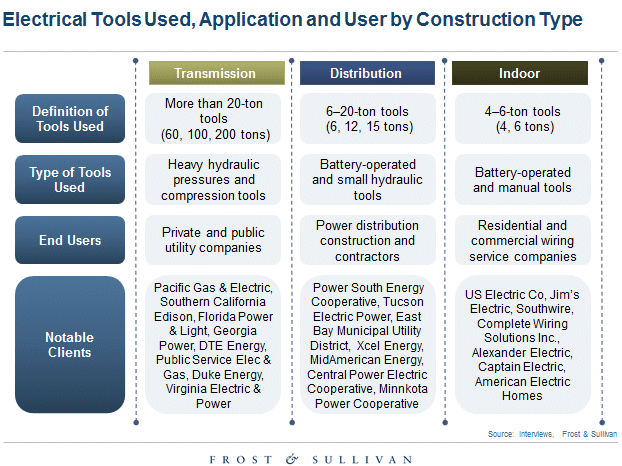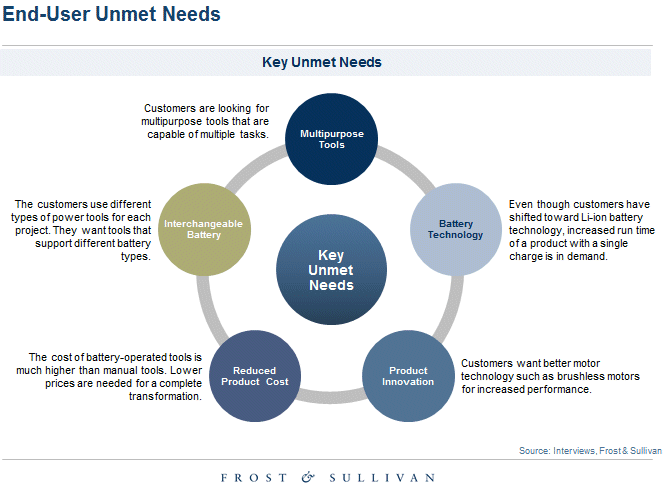Electric and gas utility capital expenditure (CAPEX) by US investor-owned utilities (IOUs) was about $115 billion in 2016. This includes upgrading aging infrastructure and installing new power generation, renewable power generation, and distribution of natural gas pipelines. A substantial portion of US infrastructure is 50 to 70 years old and requires immediate investment for refurbishment. IOUs have invested about $44 billion in upgrading the electric transmission and distribution (T&D) system and modernizing the grid with information and communication technologies.
To support the infrastructure expansion, battery-operated electric tools are in demand mainly because of their ease of use. There is an increasing shift toward battery-operated crimping tools because of the need for higher forces. The current percentage is 70% battery and 30% manual. Utility companies are concerned about repetitive muscle injuries from long-term use of manual tools.
Safety is a key criterion in selecting electric tools. Many larger utility companies have shifted to battery-operated tools. Ergonomic tools reduce repetitive-motion injuries. End users prefer battery-operated tools to prevent repetitive-motion injuries. This also is a concern for utility companies, which calculate lost worker time and other factors to determine their return on investment in tool purchases.
Overall, end users prefer battery-operated electric tools but sometimes purchase manual electric tools because of lower price. Battery-operated tools tend to be 30% to 40% higher in price than manual electric tools.
Tool manufacturers are pushing the value proposition and cost savings of battery tools through demonstrations and trials.
General Market Overview
Frost & Sullivan has conducted extensive research in the field on battery operated tools and findings indicate that the total market reached $164 million in 2016. Frost & Sullivan foresees a sustained strong single growth picking up to a 9.6% compound annual growth rate (CAGR) over the period 2016–2021. The market growth is driven by increased investments in utility expansion and refurbishing existing utility infrastructures.
When it comes to utilities, Greenlee, Burndy, and Huskie dominate the market with 77% of the total market in the United States. Milwaukee is rapidly gaining market share with sale of battery operated tools into its existing customer base in power tools segment and penetrating the industrial sector.
Almost 63.5% of the total US battery operated tools market is coming from crimping and cutting tools. Most of the tool manufacturers make the dies as well. Some of them outsource the tools so they eventually outsource the dies. Burndy makes everything by itself, Greenlee uses Klauke dies.
Apart from utility sector, companies have focused on areas such as oil & gas, railways, railroads, industrial underground, underwater like boating wire rope elevators, and any kind of rigging. Transportation, plumbing, oil & gas, mining, HVAC, and heavy machinery are among the end-user verticals for pressing and crimping tools. Electric transportation is a new market with high growth potential globally.

In utility sector, the indoor segment generates about 62% of the electric tools revenue. The main reason for the increased growth indoor is the increased emergence of new small contractors and dealers. The indoor market is expected to have more customers and end users that will use tools from the meter to indoor wiring applications. Higher growth is coming from data centers and commercial buildings with constant changeover due to renovation and upgrades. There is a short sales cycle (1 week to 1 month) for indoor. Tool procurement is expected to be higher among indoor customers.
The power distribution customer base is more stable than in indoor wiring, with a few new customers from year to year. There are not many new customers every year in electrical transmissions and power distribution. This is a fixed market with a few new customers and similar tool amounts required each year. There is a longer sales cycle (2 to 5 months). Growth depends on specific projects driven by rebuilding the network.
The procurement process for electric tools is longer for electric transmission companies because of formalities such as quality inspection and approvals for use. Distribution and indoor procurement are less complicated—mainly decided by the contractor or the end user.
In general, the utility companies have a cyclic pattern of procuring tools for every 2-3 years in transmission and power distribution, unless they have a huge requirement in between.

For indoor wiring, users require 4 or 6-ton hand compression tools. For battery tools, 6 tons are mainly used in indoor and power distribution. More indoor tools are sold because there are more termination points and many smaller connections. Indoor wiring includes work on actual termination of switch gears in the building that generally requires electric tools. The non-residential sectors such as institutional, factories and data centers are the major end-users which use 6 tons electric tools than the residential sectors. Thus covering the residential and non-residential sectors, the indoor segment covers 62% of the total utility market.
For power distribution, users are dealing with 6, 12, 15 tons type of applications. 12-ton tools are used in bringing power to the curb or to the structure. 6-ton tools are used for electrical distribution within the structure or facility.
Overall, larger tools with 60, 100, or 200 ton compression are being used in transmission and distribution at the substation level. Users need a much larger tool to operate at the substation level and distribution.
Trends Related to Standardization of Battery
There is 100% compliance in adopting lithium Ion battery technology for electric tools in the United States. The capacity is increasing but through different technologies, manufacturers are gaining extra runtime in their upgraded batteries. All 5 manufacturers have kept the form factor and weight the same from 3Ah/4Ah to their newer 5Ah. This means more charge for a cordless tool without adding bulk.
The top electric tools manufacturers are choosing Makita battery for its performance and durability. User requirements are focused on battery interchangeability to provide flexible tool usage. Battery interchangeability must be in reference to use a battery between different brand tools. There is a need to focus on offering one battery platform that includes all the power and battery operated tools. Essentially users can have one battery and one charger for all the tools being provided, including cutting and crimping. There is a need to focus on improving battery performance and charge time because utilities need immediate response when the power is out (the average is 30 minutes and 150 cycles per charge for 6 tons).

End-User Unmet Needs
Demand for multipurpose tools is growing. Customers are looking for multipurpose tools that are capable of multiple tasks. Small contractors with 5 to 10 workers prefer a single tool that can perform the job of three conventional tools. There is an increasing requirement for battery-powered electrical tool that can cut wires, crimp lugs, and punch electrical boxes.
There is an increasing requirement for interchangeable battery options. Users use different types of power tools for each project. They want tools that support different battery types.
A key requirement for battery technology is increased run time with a single charge. On an average, a user expects about 100 to 150 cycles or crimps per full charge. Manufacturers advise service after each 10,000 cycles. End users want product features such as battery and pressure level indicators, and internal cycle counters that determine tool maintenance schedules.
There is demand for some Bluetooth communications capability from the management level. Interest in tool tracking or asset management is increasing, especially in large capital projects. This technology is still new, and there is no effective GPS solution yet for cutting and crimping tools. Less than 5% of tools in the US market have a tracking capability. Using Bluetooth and phones can enable connectivity, but GPS-enabled tools are desired for remote utility plants.
Customers want better motor technology such as brushless motors for increased performance. Market participants are looking at brushless motor technology for advantages of higher motor efficiency increased running time, minimal heat, high power, compact size, light weight, and precise motor control. An estimated 10% to 20% of power tools sold today use brushless motor technology. The combination of fast-charging lithium-ion batteries and efficient brushless motors has increased productivity.
Last Thoughts
Utility companies consider product design to increase worker productivity. Battery-operated tools that are lightweight and ergonomic are ideal for repetitive-motion tasks to prevent injuries. Users across utility and industry sectors purchase electric tools at the calendar year in Q4 (starting from October to December). This represents around 60% of total sales.
Some of users in industrial sectors are buying electric tools based on the budget allocated for each project (includes both new and reconstruction projects). Initial estimation for the project requirement is accessed and the battery operated tools are procured based on the requirement. In this case, total sales coming from new project initiated is around 30%. Overall, manufacturers need to put a stronger focus on July -September marketing campaigns to make sales occur in October –December when the majority of sales occur.
Customers consider brand reputation for performance and features. In addition, they are willing to use a single brand across the whole project, such that the flexibility of using the same tools at different places/sites is high.



